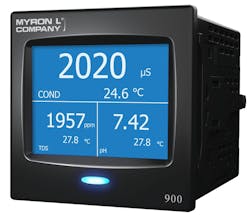Increasing Efficiency in Boilers & Cooling Towers through Water Quality Management
Myron L
760.438.2021
Boilers and cooling towers share two major water-related problems: deposits and corrosion. As steam is generated by a boiler or water evaporating from a cooling tower, dissolved minerals are left behind, increasing the concentration of these minerals. Additional minerals are introduced via the water added to makeup the water lost to steam/evaporation. Eventually, the minerals reach a level (or cycle) of concentration that will cause either loss of efficiency due to scale or damage from corrosion. This level can be determined by the Ryznar or Langelier indices and correlated to a conductivity or TDS range.
Most people recognize problems associated with corrosion. A variety of water treatment methods are employed to control these problems. Even with water treatment, it is still necessary to regularly blow down or bleed off part of the concentrated water and make up with lower salinity water to reduce the overall mineral concentration.
To conserve water and treatment chemicals, it is desirable to allow the dissolved minerals to reach a maximum cycle of concentration while still avoiding problems. Because feed water/make-up waters vary in the types and amounts of minerals present, the allowable cycles of concentration will vary. As a result, regular testing of boiler and cooling waters is essential to optimize water treatment programs and blowdown schedules. Tests commonly performed include conductivity or TDS, pH and ORP.
Conductivity is the measurement of a solution’s ability to transmit an electrical current. Pure water is actually a poor electrical conductor (18,200,000 ohms/cm of resistance). It is the amount of ionized substances (or salts) dissolved in water which determines the conductivity. Because the vast majority of the dissolved minerals in water are these conductive inorganic impurities, conductivity measurement is an excellent indicator of mineral concentration. TDS values can be derived from conductivity measurements using a non-linear correlation curve if the desired measurement units are ppm or ppt.
Boiler water requirements can range from very pure to more than 6,500 microsiemens, depending on size, pressure, application, and feedwater. Once the maximum cycles of concentration have been established, a conductivity instrument can conveniently help determine if the blowdown schedule is adequate. Cooling towers also use conductivity along with pH to precisely maintain a water treatment program. Myron L handheld portable meters generate lab-accurate readings that allow users to verify system performance and make adjustments before upsets cause rapid scaling or other damage.
Myron L 900 Series in-line controllers can be used to monitor and control the critical water quality parameters in boiler and cooling tower water quality management. All in-line instruments must be calibrated regularly to ensure fouling or drift of the sensor has not occurred. Myron L portable instruments provide rapid verification of the accuracy of in-line controllers.
